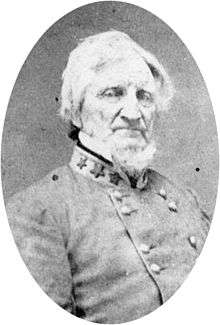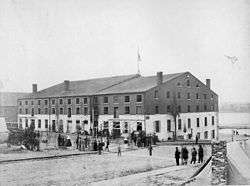John H. Winder
| John Henry Winder | |
|---|---|
 John Henry Winder, Brigadier General in the Confederate Army | |
| Born |
February 21, 1800 Somerset County, Maryland |
| Died |
February 7, 1865 (aged 64) Florence, South Carolina |
| Place of burial | Green Mount Cemetery |
| Allegiance |
|
| Service/branch |
|
| Years of service |
1820–23, 1827–61 (USA) 1861–65 (CSA) |
| Rank |
|
| Unit |
4th U.S. Artillery U.S. Rifle Regiment 3rd U.S. Artillery 1st U.S. Artillery |
| Commands held | Confederate Bureau of Prison Camps |
| Battles/wars | American Civil War |
John Henry Winder (February 21, 1800 – February 7, 1865) was a career United States Army officer who served with distinction during the Mexican War. He later served as a Confederate general officer during the American Civil War.
Winder was noted for commanding prisoner-of-war camps throughout the South during the war, and for charges of improperly supplying the prisoners in his charge.
Early life and career
Winder was born at "Rewston" in Somerset County, Maryland, a son of U.S. Army Brig. Gen. William H. Winder and his wife Gertrude Polk.[1] Winder's father fought in the War of 1812, most notably, as the American commander, in the disastrous and rallying defeat at the Battle of Bladensburg and was a second cousin to future Confederate general Charles Sidney Winder.[2]

In 1814 Winder entered the United States Military Academy at West Point, and graduated 11th of 30 cadets in 1820. He was commissioned a second lieutenant in the artillery,[2] and served first at Fort McHenry in Baltimore, Maryland, and then in Florida.[1]
During the early 1820s Winder went through numerous transfers going from the U.S. Rifle Regiment in 1820, to the 4th U.S.[3] Winder resigned his commission on August 31, 1823, and would be out of the Army for almost four years.[2] Later in 1823 Winder married Elizabeth Shepherd. The next year his father died, putting him in a deep economic strain, and his mother was forced to make her home into a boardinghouse. Winder had failed to manage his father-in-law's plantation successfully, so he was unable to help his mother. In 1825 Winder's wife Elizabeth died, leaving him to raise their young son William and forcing him to go back into duty in the U.S. Army.[3]
On April 2, 1827, Winder was reinstated as a second lieutenant, and he served in the 1st U.S. Artillery. He would be promoted to first lieutenant on November 30, 1833.[2] He then taught tactics at West Point in 1837.[4] He lost his job at West Point after one year, though, because of a temper that he got with a cadet.[3] Winder then became the 1st Artillery's Regimental Adjutant from May 23, 1838, until January 20, 1840. He was promoted to captain on October 7, 1842.[2]
Mexican War
Winder fought well in Mexico, winning brevet promotions to major on August 20, 1847 (for both his conduct at the Battle of Contreras and for the Battle of Churubusco) and to lieutenant colonel on September 14 (for his actions at the Battle for Mexico City.) He was also wounded in the fight near the Belén Gate, which guarded an approach into Mexico City, on that same day. After the war he was promoted to major on November 22, 1860.[5]
American Civil War
Winder chose to follow the Confederate cause and resigned his U.S. Army commission on April 27, 1861. He was appointed a colonel in the Confederate Army infantry on March 16. He was then promoted to brigadier general on June 21 and the next day was made Assistant Inspector General of the Camps of Instruction that were in the Confederacy's capital of Richmond, Virginia, a post he would hold until October 21.[2] In addition to his duties involving prisons, he was responsible for dealing with deserters, local law enforcement, and for a short time setting the commodity prices for the residents of a city dealing with a doubled population.[6] During this time he commanded Libby Prison in Richmond as well.

In April 1864, Winder appointed Capt. Henry Wirz commandant of a new prison camp in Georgia called Camp Sumter, better known as the infamous Andersonville Prison. Winder commanded the Department of Henrico for much of the war, lasting until May 5, 1864. He then commanded the 2nd District of the Department of North Carolina & Southern Virginia from May 25 until June 7.[3] Ten days later he briefly commanded Camp Sumter himself, lasting until July 26. Winder then was given command of all military prisons in Georgia as well as those in Alabama until November 21, when he was put in charge of the Confederate Bureau of Prison Camps, a post which he held until his death on February 7, 1865.[2]
Death and legacy
Winder died on duty in Florence, South Carolina, of a heart attack in 1865.[7][8] His body was brought back to Maryland and interred at Green Mount Cemetery in Baltimore.[2]
The assignment to run prisons in the South during the American Civil War was a difficult job at best, hampered by the Confederacy's poor supply system combined with diminishing resources. In their post-war writings, some of the high level leaders of the Confederate government voiced the difficulties of Winder's assignment, saying:[9]
...President Davis, Secretary Seddon, and Adjutant Cooper declared that he was a much-maligned man. He was set to perform a task made impossible by the inadequacy of supplies of men, food, clothing, and medicines.[9]
During the war, Winder was frequently derided in Northern newspapers, who accused him of intentionally starving Union prisoners. Military historian Ezra J. Warner believed these charges were without merit, saying "Winder adopted every means at his command to assure that the prisoners received the same ration as did Confederate soldiers in the field, scanty as that allotment was."[6]
However, in John McElroy's eyewitness account in his 1879 book Andersonville, it appears clear that this is a biased and extremely misleading account. Winder is quoted as saying "I am killing off more Yankees than twenty regiments in Lee's army." On July 27, 1864, in his order No. 13, he ordered that if Federal troops came within 7 miles of Andersonville, the guards where to "open upon the Stockage with grapeshot [using the numerous cannons that were trained on the prisoners] without reference to the situation beyond these lines of defense." Major causes of the high mortality rates in Andersonville, Florence and other prisons overseen by Winder were scurvy (easily avoided with inexpensive food sources of vitamin C) and exposure. Most men had to sleep on the ground, even in freezing weather. The camp was in a wilderness area surrounded by forest, but they were not allowed to build huts or reasonable fires for cooking their daily ration of less than one pint of poorly ground corn meal. At the post-war trial of Captain Henri Wirz who ran Andersonville, dozens of nearby neighbors testified that there was plenty of food available in that part of Georgia at that time. Sherman also found plenty in the rest of the state.
John H. Winder appears as a character in MacKinlay Kantor's 1955 novel Andersonville, which won the Pulitzer Prize for Fiction. He is glimpsed briefly in Chapter III; beginning in Chapter XV, his character comes fully into focus, an angry and bitter man who "preferred to sit brooding silently on whatever foul nest he'd constructed with the beak and claws of his hatred."
During the Civil War, Camp Winder and the Winder Hospital in Richmond were named after him.[10]
See also
Notes
- 1 2 Wakelyn, p. 442.
- 1 2 3 4 5 6 7 8 Eicher, p. 757.
- 1 2 3 4 Blakey's p. 76.
- ↑ Warner, p. 340.
- ↑ Blakely, p. 76; Eicher, p. 575.
- 1 2 Warner, p. 341.
- ↑ PDDOC biography of Winder. possible cause of death "...from disease contracted while visiting the prison stockade at Florence."
- ↑ Wakelyn, p. 443. Attributes death to "anxiety and fatigue"
- 1 2 "PDDOC biography of Winder". www.pddoc.com. Retrieved 2008-10-17.
- ↑ Winder Hospital, Civil War Richmond, www.mdgorman.com
References
- Blakey, Arch Fredric; "General John H. Winder, C.S.A,", University Press of Florida, 1990, ISBN 0-8130-0997-9.
- Eicher, John H., and Eicher, David J., Civil War High Commands, Stanford University Press, 2001, ISBN 0-8047-3641-3.
- Sifakis, Stewart. Who Was Who in the Civil War. New York: Facts On File, 1988. ISBN 978-0-8160-1055-4.
- Wakelyn, Jon L., Biographical Dictionary of the Confederacy, Greenwood Press, 1977, ISBN 0-8371-6124-X.
- Warner, Ezra J. Generals in Gray: Lives of the Confederate Commanders. Baton Rouge: Louisiana State University Press, 1959. ISBN 978-0-8071-0823-9.
- www.pddoc.com PDDOC biography of Winder.
External links
- John H. Winder in Encyclopedia Virginia
- www.hmdb.org Winder's stone marker in Salisbury, Maryland.